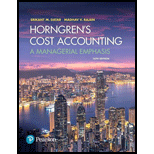
Horngren's Cost Accounting: A Managerial Emphasis (16th Edition)
16th Edition
ISBN: 9780134475585
Author: Srikant M. Datar, Madhav V. Rajan
Publisher: PEARSON
expand_more
expand_more
format_list_bulleted
Concept explainers
Textbook Question
Chapter 13, Problem 13.1Q
What are the three major influences on pricing decisions?
Expert Solution & Answer
To determine
Pricing Decisions:
Pricing decisions are those decisions that are related to ascertain the price of a particular product or services.
To identify: The factors that influence the pricing decisions.
Answer to Problem 13.1Q
The tree most important factor that influences the pricing decision is as follows,
- Customers
- Competitors
- Costs
Explanation of Solution
- Customers are the most important factor that influences the pricing decisions as the price of a particular product is influenced by the customers demand and supply of those particular goods.
- Competitors are also an important factor that influences the pricing decisions as the manager ascertain the cost of its competitors as to make changes while pricing and it also tells managers as how much the price would be set by the competitor.
- Costs is another factor that influences the pricing decisions as lower the cost the more the company can produce and can sell in major volume.
Conclusion
Hence, the factors that influence decisions are customers, cost, and competitors
Want to see more full solutions like this?
Subscribe now to access step-by-step solutions to millions of textbook problems written by subject matter experts!
Students have asked these similar questions
Can you help me solve this financial accounting question using the correct accounting procedures?
Please provide the accurate answer to this financial accounting problem using valid techniques.
Please provide the answer to this general accounting question using the right approach.
Chapter 13 Solutions
Horngren's Cost Accounting: A Managerial Emphasis (16th Edition)
Ch. 13 - What are the three major influences on pricing...Ch. 13 - Relevant costs for pricing decisions are full...Ch. 13 - Describe four purposes of cost allocation.Ch. 13 - How is activity-based costing useful for pricing...Ch. 13 - Describe two alternative approaches to long-run...Ch. 13 - What is a target cost per unit?Ch. 13 - Describe value engineering and its role in target...Ch. 13 - Give two examples of a value-added cost and two...Ch. 13 - It is not important for a company to distinguish...Ch. 13 - Prob. 13.10Q
Ch. 13 - Describe three alternative cost-plus pricing...Ch. 13 - Give two examples in which the difference in the...Ch. 13 - What is life-cycle budgeting?Ch. 13 - What are three benefits of using a product...Ch. 13 - Prob. 13.15QCh. 13 - Which of the following statements regarding price...Ch. 13 - Value-added, non-value-added costs. The Magill...Ch. 13 - Target operating income, value-added costs,...Ch. 13 - Target prices, target costs, activity-based...Ch. 13 - Target costs, effect of product-design changes on...Ch. 13 - Target costs, effect of process-design changes on...Ch. 13 - Cost-plus target return on investment pricing....Ch. 13 - Cost-plus, target pricing, working backward....Ch. 13 - Life-cycle budgeting and costing. Arnold...Ch. 13 - Considerations other than cost in pricing...Ch. 13 - Cost-plus, target pricing, working backward. The...Ch. 13 - Value engineering, target pricing, and target...Ch. 13 - Target service costs, value engineering,...Ch. 13 - Cost-plus, target return on investment pricing....Ch. 13 - Cost-plus, time and materials, ethics. C S...Ch. 13 - Cost-plus and market-based pricing. Georgia Temps,...Ch. 13 - Cost-plus and market-based pricing. (CMA, adapted)...Ch. 13 - Life-cycle costing. Maximum Metal Recycling and...Ch. 13 - Airline pricing, considerations other than cost in...Ch. 13 - Prob. 13.35PCh. 13 - Ethics and pricing. Instyle Interior Designs has...Ch. 13 - Value engineering, target pricing, and locked-in...
Knowledge Booster
Learn more about
Need a deep-dive on the concept behind this application? Look no further. Learn more about this topic, accounting and related others by exploring similar questions and additional content below.Similar questions
- On April 1, Usain Enterprises purchased machinery at a cost of $150,000, with a depreciable cost of $120,000 and an estimated useful life of 4 years. Using the straight-line depreciation method, calculate depreciation expense for the first year, which ends on December 31.arrow_forwardStep by step solution for general accountingarrow_forwardPlease explain the solution to this general accounting problem with accurate principles.arrow_forward
- Corona Distributors has received an invoice totaling $80,000 with payment terms of 2/15, net 60. This means the buyer can avail a 2% discount if the invoice is paid within 15 days; otherwise, the full amount is due in 60 days. How much does the buyer save if the bill is paid within the discount period a. $800 b. $1,600 c. $2,400 d. $3,200arrow_forwardI need the correct answer to this financial accounting problem using the standard accounting approach.arrow_forwardWhat is the correct price of the stock and accounting questionarrow_forward
arrow_back_ios
SEE MORE QUESTIONS
arrow_forward_ios
Recommended textbooks for you
 Cornerstones of Cost Management (Cornerstones Ser...AccountingISBN:9781305970663Author:Don R. Hansen, Maryanne M. MowenPublisher:Cengage Learning
Cornerstones of Cost Management (Cornerstones Ser...AccountingISBN:9781305970663Author:Don R. Hansen, Maryanne M. MowenPublisher:Cengage Learning Managerial AccountingAccountingISBN:9781337912020Author:Carl Warren, Ph.d. Cma William B. TaylerPublisher:South-Western College Pub
Managerial AccountingAccountingISBN:9781337912020Author:Carl Warren, Ph.d. Cma William B. TaylerPublisher:South-Western College Pub- Century 21 Accounting Multicolumn JournalAccountingISBN:9781337679503Author:GilbertsonPublisher:Cengage
 Principles of Cost AccountingAccountingISBN:9781305087408Author:Edward J. Vanderbeck, Maria R. MitchellPublisher:Cengage Learning
Principles of Cost AccountingAccountingISBN:9781305087408Author:Edward J. Vanderbeck, Maria R. MitchellPublisher:Cengage Learning

Cornerstones of Cost Management (Cornerstones Ser...
Accounting
ISBN:9781305970663
Author:Don R. Hansen, Maryanne M. Mowen
Publisher:Cengage Learning

Managerial Accounting
Accounting
ISBN:9781337912020
Author:Carl Warren, Ph.d. Cma William B. Tayler
Publisher:South-Western College Pub


Century 21 Accounting Multicolumn Journal
Accounting
ISBN:9781337679503
Author:Gilbertson
Publisher:Cengage

Principles of Cost Accounting
Accounting
ISBN:9781305087408
Author:Edward J. Vanderbeck, Maria R. Mitchell
Publisher:Cengage Learning
Pricing Decisions; Author: Rutgers Accounting Web;https://www.youtube.com/watch?v=rQHbIVEAOvM;License: Standard Youtube License